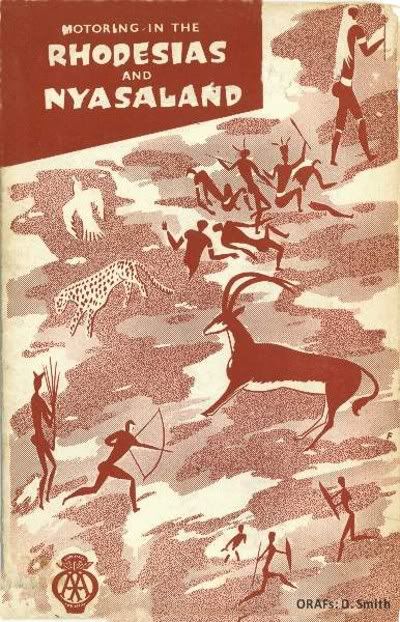
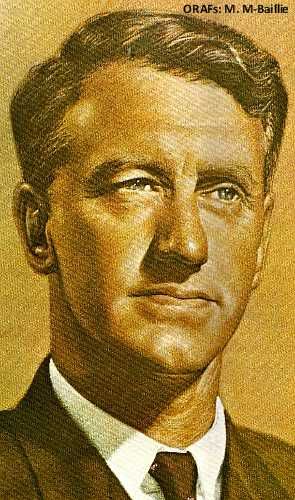
. .let us get on with the task before us, of building up our wonderful country. We can do this confident of what the future holds, knowing we are working for generations to come,as far ahead as reasonable men can visualise. I wonder what better prospects, what better guarantee,any other country in the world can offer its people?"
The Prime Minister, the Hon. Ian Douglas Smith, I.D., M.P.
Motion on the President's Speech. House of Assembly.
29th June. 1973. The past ten years have seen incredible advances in almost every sphere of life in Rhodesia, advances made possible by strong Government and a united people working together for a brighter future for the whole country.
This brochure analyses some of the changes that have taken place in the period the Rhodesian Front has been in power.
It reviews some of the main achievements—and also looks at the future to see what Rhodesia has in store for its people.
BIRTH OF A PARTYThe late 1950s—early 1960s will always remain in the minds of Rhodesia ns as a period of unrest and frustration in the political sphere.
It was also a period when, encouraged by the United Kingdom Government's policy on "winds of change" and immediate handover to the unsophisticated. African nationalism was becoming extremely militant and vociferous in its public statements and action.
Events leading up to the dissolution of the Federation and the Conference on the new Constitution for what was then Southern Rhodesia, all had an unsettling effect on its peoples.
It was against this background that the then Prime Minister of Southern Rhodesia. Sir Edgar Whitehead, approached the British Government with his proposals for a new Constitution.
It is important to note that the majority of the electorate was fully convinced that, in accepting this Constitution, Rhodesia would attain complete independence except in two minor matters, and that the British Government would have no authority to interfere in the internal affairs of the country. This conviction was engendered by public statements of Sir Edgar Whitehead with the full backing of Sir Roy Welensky and his Federal Government, by representatives of the British Government and by the written word contained in the British proposals.
The referendum for the 1961 Constitution was a bitter conflict; the opposition was fierce and outspoken. The main reasons for the opposition were the anticipated repeal of the Land Apportionment Act, the inherent d fingers of the common voters roll, the suggested franchise and the ingenious cross voting system. The Whitehead Government tried to minimise the effect of these points and promised safeguards for the European. The electorate for the last time placed their faith in this liberal element. The referendum was won by the United Federal Party and the now Constitution came into being.
The true intention of the ruling party in regard to Land Tenure can best be illustrated by excerpts from the United Federal Party's African publication "UKURU" in the issue of January. 1962;
"The big news in 1962 will be the complete repeal of the Land Apportionment Act. This means that you, If you can afford it. will be able to live wherever you like in Southern Rhodesia, even in the big cities like Salisbury and Bulawayo." and on page 11 of the same issue a significant pointer to Policy:
"Under the new Constitution the reserves are permanently kept for occupation by the African people, this is 21 million acres, nearly a quarter of Southern Rhodesia. This is racial discrimination AGAINST the European."
It was now obvious that the policy of the United Federal Party would not guarantee the security of the European as it accepted African majority rule and the success of African nationalism as inevitable in the near future. This was borne out by the deliberate attempt to undermine the authority of the chiefs and the tribal system. Many Rhodesians at this time decided to leave Rhodesia end the emigration figures indicated that a mass exodus was under way.
Rhodesians, old and new alike, spontaneously rejected the new philosophy of the United Federal Party when the implications of the 1961 Constitution became apparent. Large numbers of prominent members of the United Federal Party, who had been associated with Sir Godfrey Huggins throughout his long political carer and followed him through thick and thin, resigned from the Party.
It was clear that too many groups would not be successful in fighting the party in power. Consequently, the leading personalities agreed that, an amalgamation of all groups should take place to form one consolidated front.
With the birth of the Rhodesian Front a new wave of hope was evident, despite events in the rest of Africa and despite the cries of the inevitability of black majority party rule. Rhodesians rallied to the flag and funds flooded into the coffers of the now party. Under the leadership of Mr. Winston Field the party gathered momentum and fierce upsurge of white nationalism and patriotism waft evident in the election of 1962.
The traditional way of life in Rhodesia had been threatened and Rhodesians reacted. They rejected the multiracial policies of the United Federal Party with its common voters' roll and sought security of land tenure. They rejected forced integration and sought the traditional way whereby people could preserve their own way of life and identity in their own areas and, most importantly, they turned their backs on the "winds of change".
The Rhodesian Front, with its assurance of a permanent future for all races in Rhodesia, the retention of Government in responsible hands and the entrenchment of the Land Apportionment Act., achieved victory at the polls.
In 1965, the electorate overwhelmingly supported the Rhodesian Front to give the Party all 50 European seats in Parliament.
At the referendum in 1969 80.96% of the electorate voted for Republican status and 72.48% voted in favour of the 1969 Constitution.
The General Election of 1970 saw the electorate once again place their faith in the policies of the Rhodesian Front by returning their candidates to all 50 European seats.
 SO FAR - AND NO FURTHER!The Road to U.D.I
SO FAR - AND NO FURTHER!The Road to U.D.IRhodesia's path through African history is littered with the broken promises of successive British governments. As far back as 1922, a referendum majority voted for responsible government after being given the right to self-determination. Over the years, as the country grew, a new Rhodesian emerged. Unlike some states in Africa, where the European was a bird of passage, the white Rhodesian was "here to stay"; this was his only home; it was his country. There were second, even third generation Rhodesians of European descent. They knew they had to live with the results of their actions in Rhodesia ; they could not retreat to some other country. Perhaps for this reason they succeeded in raising their African fellow-countrymen to higher standards than existed in countries to the north.
By 1953, Rhodesia could have had Dominion status — full independence — for the asking. Instead the country voted to join Northern Rhodesia and Nyasaland in a Federation. A Federation, Rhodesians were told, which must be permanent and could not be broken up.
As late as 1957, the British Government was still committed to this concept. Then, within two years, the Monkton Commission was considering the question of secession—and, three years later, Nyasaland and Northern Rhodesia were given permission to secede. In 1961, Sir Edgar Whitehead, the then Prime Minister, negotiated a new Constitution for Rhodesia with the British Government. This 1961 Constitution was presented to the Rhodesian electorate and was accepted at a referendum with the promise that it would ensure independence for Rhodesia.
In return for the assurance of independence, the electorate agreed to substantial political concessions to the African people. These were contained in the 1961 Constitutional Proposals and included the provision of 15 seats in Parliament for Africans, and the prospect of a rapid increase in the number of Parliamentary seats held by Africans. However, the promise of independence for Rhodesia proved false.
In 1962, the first elections were held under the 1961 Constitution, as a result of which the Rhodesian Front came to power.
A conference to dissolve the Federation was held in 1963 and Southern Rhodesia stipulated as a condition of attendance that independence would be granted no later than to the other members of the Federation—if not before. Britain agreed to this. Again, when the time came, the promise was broken.Rhodesia maintained pressure on the British Government for independence. In September, 1964 Britain agreed that, if it could be shown that the majority of Rhodesians supported independence under the 1961 Constitution, independence would be granted. In spite of an overwhelming referendum vote in favour and an "indaba" of Chiefs and Headmen giving
unanimous support, Britain again refused to honour the under- taking.
Rhodesians at this time were becoming increasingly aware of the succession of disasters in many nearby African countries brought about by the premature withdrawal of European influence. Many of the newly independent states turned rapidly into dictatorships; Rhodesia saw a steady stream of refugees fleeing chaos and bloodshed. Rhodesians hardened their determination that this would never happen in their own country.
In June, 1965, Rhodesia's traditional invitation to the Commonwealth Prime Ministers' Conference was withdrawn. Worse, Britain was forced to relinquish her position as leader at the Conference. The majority of members represented Afro-Asian countries and they dominated by sheer weight of numbers. To Rhodesians, it was now imperative that they must have their independence.
In October, 1965 the Prime Minister went to London for what were described as "final and conclusive talks" on the issue. Within a week these had broken down. The British Government reneged on its predecessor's undertaking and declared that independence under the 1961 Constitution was no longer acceptable. Taking all these factors into consideration, including the British Government's controlling rights under the 1961 Constitution, it now seemed to Rhodesians that a unilateral declaration of independence was the only solution to obtain what was their right and what had been promised to them. But within a month the British Prime Minister was in Salisbury and it was agreed that a Royal Commission be set up to determine whether Rhodesians as a whole would accept independence under the 1961 Constitution. Rhodesians hailed this most significant breakthrough. Mr. Wilson returned to Britain. Then, before the House of Commons, he said his Government reserved the right to accept or reject the Commission's findings—an act tantamount to rejection of the Salisbury agreement!
Surprised and disillusioned, Rhodesians wondered what more could be required of them. Their country had proved itself economically viable. For 43 years there had been stable self-government bringing education, welfare and health facilities un- equalled anywhere to the north. Yet other African countries with nothing like this record had gained their independence, sometimes with almost indecent haste.
It was clear that British policy was governed by a desire to please the Afro-Asian bloc. To Rhodesians, any hope of independence by negotiation was now unrealistic. The Government also knew there was no future for the country as long as it drifted in a "constitutional twilight". Steady, long-term growth would never come unless Rhodesia was master in its own house.
Rhodesians had left no stone un-turned in the long and bitter negotiations to secure a mutually agreeable settlement. All endeavours had failed. On November 11, 1965, the Prime Minister told the nation:
"In the lives of most nations there comes a moment when a stand has to be made for principle, whatever the consequence. This moment has come for Rhodesia. I pray, and I hope other Rhodesians will pray today, that our Government will be given the wisdom and the strength to bring Rhodesia safely through. To us has been given the privilege of being the first Western nation in the last two decades to have the determination and fortitude to say: “So far and no further". "We have struck a blow for the preservation of justice, civilization and Christianity and in the spirit of this belief; we have this day assumed our sovereign independence".
The Rhodesian Front Government has always followed the administration of justice adopted from the British, which guarantees the independence of the Courts and the maintenance of the rule of law in Rhodesia.
This has been so even during a situation when the legality of the Government itself was called into question when independence was declared. At that time the judges of the High Court, who had been appointed under the 1961 Constitution, did not immediately identify themselves with the 1965 Constitution. It was only in September, 1968, that the Appellate Division ruled that to continue to function as a Court, it must take cognizance of the Government as the lawful Government of Rhodesia.
It is to the credit of Rhodesia that the Government has abided strictly by the decisions of our courts and as such has not interfered with the independence of the Judiciary. The decision of the Appellate Division of the High Court to give de jure recognition to the Government and the 1965 Constitution, almost three years after the declaration of independence, was seen to be the decision of a court of unquestioned impartiality and independence.
THE ROAD TO SUCCESSThe degree of success achieved by the Government in containing inflation has created other problems and it may be necessary to adjust this policy in the interests of the country's development.
In relation to world trends, the cost of living in Rhodesia has changed comparatively little in the past ten years. During the same period, the Gross Domestic Product increased at an average rate of 6,5% per annum, culminating in a growth rate of 12% or in real terms, allowing for
inflation, a figure of 8,5%.
The high standard of living continues to improve for the average Rhodesian and he enjoys many tax relief measures instituted over the past ten years.
Look at our tax record since Independence. The income tax rate has been reduced; PAYE was introduced in 1966; immigrant abatements were increased in 1968; pension, insurance and medical aid contribution deductions improved; increased medical expenses deductions were allowed; super tax was abolished.
This is but a part of the success story. COMMUNICATIONS
COMMUNICATIONSRhodesia is a country of wide open spaces, and such great distances require excellent communications. The Government has followed a policy that ensures that the main road network is constantly expanded to meet the needs of a developing transport industry. Amendments to legislation and regulations, including a more streamlined method of handling applications for public service vehicle permits and altering the axle load restrictions to realistic levels, have greatly assisted the industry's growth. Since 1963, 1 732 km of new tarred roads have been laid which is the equivalent of the distance from Salisbury to Durban. Two hundred major bridges have been constructed during the same period.
Additional funds have been made available to local government authorities and the Ministry of Internal Affairs for secondary road networks through the allocation of motor vehicle licence fees and heavy vehicle surcharge.
Rhodesia Railways today move greater tonnages on the country's system alone than was moved by the total rail system of the Federation. The main permanent way is being re-laid to heavier track and new marshalling yards and ancillary facilities are being built. Rhodesia is now manufacturing its own range of railway trucks, refrigerator wagons, tank cars, cabooses and passenger cars and these compare favourably with imported units.
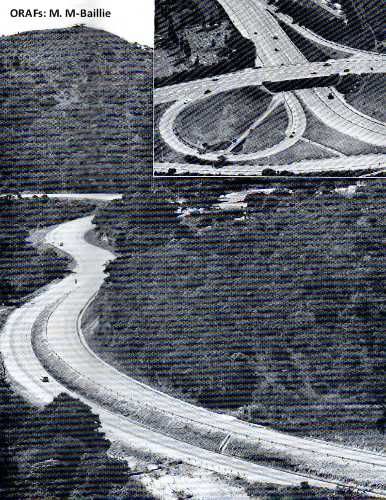
A victory for all Rhodesians was scored in April 1973 when Air Rhodesia announced that it had purchased three Boeing 720 jet aircraft. This put Rhodesia back on a competitive footing with the other airlines serving the country and was a great boost to morale among the staff at Air Rhodesia in every department. Last September, the new jets went into regular scheduled service.
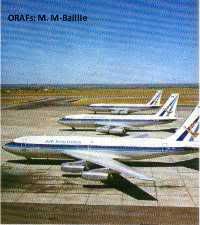
Air Rhodesia has met the challenges of Rhodesia's situation and changing demands with enthusiasm; total passenger kilometres flown continues to increase and services are steadily being improved to outlying areas.
The number of passengers carried, excluding charters, in the past ten years has nearly doubled.
During 1965 the Ministry of Posts took over, on an agency basis, all revenue collecting on behalf of Government, thus making it possible to close all Treasury Revenue offices.
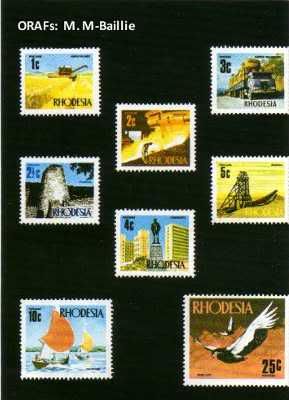
In the field of philately, a Southern Rhodesia definitive issue, to replace Federal stamps, was made in 1964. A 2/6d. "Independence" commemorative stamp was issued on 8th December, 1965, and this was the first occasion that a postage stamp had been printed in Rhodesia. There has been a regular annual programme of commemorative issues of postage stamps, all printed within the country.
The Posts and Telecommunications Corporation was constituted on 1st July, 1970, and took over all the services provided by the former Ministry of Posts.
During the last ten years, twenty-two post offices were provided, either at new centres or replacing existing post offices that were too small or old. Six post offices with adjoining telephone exchanges were also built. Four telephone exchanges were built, and additions and alterations were made to several others.
The total volume of mail matter handled increased from 99 375 000 articles to 142 362 000 articles, an increase of 43,2%.
The number of depositors in the Post Office Savings Bank increased from 326 848 to 537 724 during the period, an increase of 64,5% and the amount due to depositors increased by 110,7% from $46 011390 to $99 850 962.
Automatic service was introduced at eleven exchanges and extensions and improvements or replacements were made to sixteen other exchanges. Altogether the line capacity was increased by 25 000 lines, all of which were used to increase the number of connections from 48 000 to 73 000.

The Subscriber Trunk Dialling (S.T.D.) service was improved and extended considerably within Rhodesia and the service was recently extended internationally between Salisbury and Bulawayo subscribers and Johannesburg and the Witwatersrand subscribers. Rhodesia also has access to Beira and Lourenco Marques numbers.
Technical additions were made to our overseas telex and telephone channels and as a result an improved service is now offered and fully used.
Telephone trunk channels in use have shown an increase of 100% to over 1 600 channels.
Development of the Rural Party Line system and progression towards full automatic operation and integration with Subscriber Trunk Dialling has continued throughout the period.

 NATURAL RESOURCES
NATURAL RESOURCESRecognising the importance of Rhodesia's natural resources, the Government transferred the Natural Resources Board from the Ministry of Agriculture to the Ministry of Lands, to form the new Ministry of Lands and Natural Resources in 1972. The Natural Resources Board advises Government on conservation matters.
The Natural Resources Board has played an important role in the protection and preservation of Rhodesia's natural attractions, including the restoration and preservation of the rain forest area around Livingstone's statue at Victoria Falls and a successful move to have the position of a proposed hotel changed to save an area of unique riverine vegetation that was endangered.
The present degree of pollution in this country is minimal and the Government introduced legislation to ensure that the problems that have beset many other parts of the world do not develop here. In addition, anti-pollution research projects have received full Government support.
In 1968 the Department of National Parks and Wild Life Management opened a central booking office to assist tourists in seeing the country. The office made it possible to guide tourists to lesser known parks and to increase the occupancy of all camps.
The Government helped in the establishment on a 40 000 ha site in Chirisa Game Reserve at Sengwa Gorge of the Hostes Nicolle Institute for Wildlife Research and, on completion, this complex will consist of laboratories and research facilities that will be among the most modern in Southern Africa.
The acquisition of land in Matetsi ICA, west of the proposed game fence, will be combined with Wankie and Victoria Falls national parks to bring into being one of the greatest wildlife areas in the world from which both present and future generations of Rhodesians will derive enjoyment.
Since 1965, the timber production of the Forestry Commission has made an important contribution to the building trade and industry generally. The Rhodesian Front Government has reacted quickly to the oil energy crisis and has initiated a feasibility study on alternative sources of energy. In this regard our enormous deposits of coal are a tremendous asset and will play an invaluable part in the industrial expansion of our country.
Coal and water are two of our natural resources used to generate electricity. The rate of consumption in Rhodesia continues to increase dramatically in both primary and secondary industry as well as through domestic use. Additions to the distribution grid have brought development to many parts of Rhodesia and the provision of additional generating plants will ensure that further development can be sustained. The cost of electrical power in Rhodesia has been kept to a level that compares well with other countries and this has encouraged the setting up of industries dependent on large supplies of cheap power. Today the country's consumption and distribution is far higher than was ever contemplated even in the boom days of Federation.
Rhodesia's Department of Meteorological Services has made impressive progress in experimentation in cloud seeding. The country is now among the world's foremost in this field.
The staff of the department has displayed exceptional ingenuity by building its own tracking and receiving station which regularly monitors weather satellites passing over head.
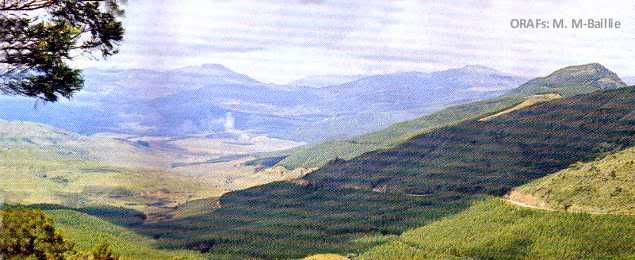
The Department produces a steady stream of information for agriculture and industry to assist in forward planning.
Water is Rhodesia's lifeblood—and no Government has recognised this more than the Rhodesian Front. In the eleven years before this Government came to power, only ten large dams were built in Rhodesia. In the first three years of the present administration, this figure doubled and in the eleven years of Rhodesian Front Government 40 large dams have been completed.
Hand in hand with the increasing water storage facilities, irrigation in Rhodesia has grown in the past decade. There has been a threefold increase in the area under irrigation since UDI.
Typical of Government assistance has been the development of large scale estates, such as those under the Sabi-Limpopo Authority. The Government set up this authority in 1964 and within nine years 12 465 ha were under irrigation in this scheme alone. The total area of 6 000 ha at Middle Sabi will be settled and of the 6 465 hectares at Mkwasine so far 1093 ha is under settlement.
The Government has encouraged irrigation methods amongst African farmers and to date has developed 4 900 hectares as well as 1 416 hectares under TILCOR, and with a further planned expansion of 9 560 hectares due for completion by 1976
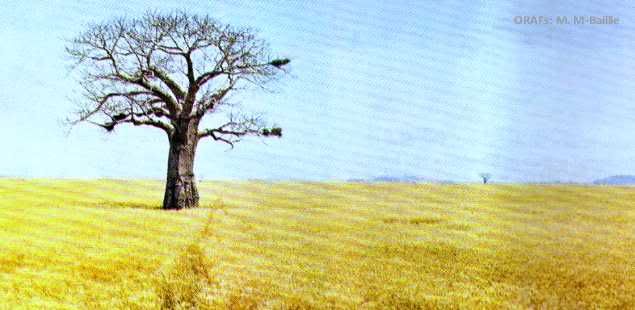 SOCIAL SERVICES
SOCIAL SERVICESRhodesia's education system is equal to the best in the world. To maintain these high standards, the Government has done much to expand facilities and take advantage of continuing new developments in this vital field.
Even taking into consideration the growth in population since 1964, there has been a considerable percentage improvement in our examination successes which is reflected in the proportionate increase in passes: at '0' level the numbers obtaining four or more passes increased by 84%; at 'M' level there has been an increase in the pass rate of nearly 35%, whilst at 'A' level the increase has been in the order of 40%.
An important development has been the introduction of the Rhodesian Certificate of Education in line with the best principles of modern testing procedure, and tailored to meet the needs of Rhodesia.
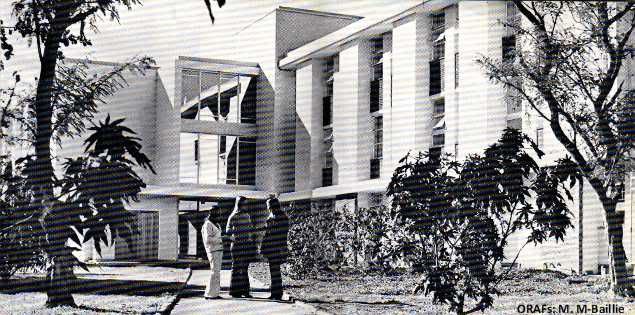
Rhodesia's syllabuses and school buildings are constantly modernised. To meet this demand, expenditure nearly doubled from 1964 to 1973. Provision for school buildings has increased from $118 000 in 1965 to $3 700 000 in 1973/74.
A unique development in primary education started in 1971 in Wankie with the first Rhodesian Educational Course in Conservation and Environmental Studies (RECCE). Now in a permanent home at Mushandike, the one week course for children and teachers last year attracted 1710 children from 49 schools. As from 1974, every child ip Standard 5 will have an opportunity to go on this sort of course.
The Government carries the full responsibility for the costs of the University of Rhodesia and in 1973/74 $4 200 000 has been provided for this purpose.
The amount spent on African education in the last decade more than doubled and the number of schools and enrolment has greatly increased.
The Government has embarked on a plan to provide more practical education to fit Africans for worthwhile employment.
African Councils have taken over many primary schools and few now remain in the hands of missionary bodies. With better trained teachers, the eight year primary course has been reduced by one year, saving more than §1200 000 a year. This saving has been reapplied elsewhere in the African education system.
Important developments have been made in further education to meet the needs of the Skilled Manpower and Apprenticeship Act and to provide a sophisticated and up-to-date service to the community in a wide range of engineering, commercial and industrial and adult education topics. Revenue for further education has risen from $750 000 in 1965 to $2 200 000 in 1973 and building expenditure jumped from $52 000 to $550 000 in the same period.
With the establishment of the Apprenticeship Training and Skilled Manpower Development Authority in 1968, a new system of apprenticeship training was introduced, involving full-time attendance at technical colleges during the early years of indenture for apprentices in the Aircraft, Building, Electrical, Motor and Printing industries, with block-release training being continued for the Mechanical Engineering industry. In addition, advanced courses of instruction have been introduced on a block release basis for those apprentices who show promise, opening up to them opportunities in the technician grades in industry.
The difficult task of calculating future skilled manpower requirements in the trades designated for apprenticeship training has been tackled and first experimental fore- casts have been produced looking ahead to 1979. These forecasts will prove of great value in assessing the size of future apprentice intakes and will provide information on which training facilities to meet requirements can be planned.
The growth in the number of young men undertaking apprenticeship training is considerable, rising from1 618 in 1968 to the present figure of 2 921 and many more are needed.
The main changes in the Government's health administration have been related to the policies of decentralisation and the fostering of community development and local government. As the result of this, nearly 100 new local authorities, in both European and African areas, are now running health services, in addition, of course, to considerable expansion of the services provided by the established municipalities. It has now been accepted that local authorities 'have the responsibility for primary care medical services, including maternity, as well as preventative services within their areas.

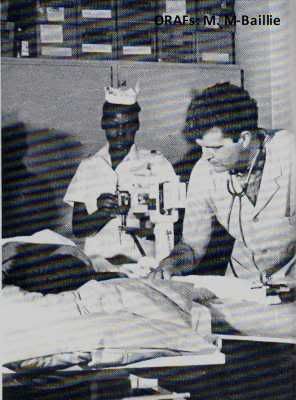
Greater involvement of local authorities in the field of mental health and care of the aged is also being encouraged.
From 1968 to 1973, a total of $5 900 000 has been spent on health buildings. New hospitals have been completed at Chiredzi, Chickuku, Bikita and Chingombe. The Municipal Hospital at Sakubva Township, Umtali, has been taken over and converted to a District Hospital. Major additions have been made to many hospitals, as well as minor additions and improvement to others. In addition to these works, the major project of a new Salisbury Central Hospital has been put in hand and the first phase has been commissioned.
Expenditure on health services in the year 1969 amounted to $13 900 000. In 1973, this had increased to $21 200 000.
Smallpox has been eradicated from Rhodesia. There have been no cases now since 1970 and leprosy too is on the way to eradication. There are no active cases in hospital, all cases now being treated as outpatients.
The incidence of tuberculosis among Africans has dropped by more than 60 percent in the last ten years. Prevention of malnutrition is a battle against prejudice and ignorance but there has been a very considerable drop in the incidence of protein calorie malnutrition, as a result of the activities of the Ministry of Health and the Freedom from Hunger Campaign.
Legislation has included the control of addictive drugs; consolidation and amendment of laws relating to the registration of doctors, dentists, nurses and other professionals allied to medicine; modernising the laws relating to the sale, importation and manufacture of foodstuffs and major anti-pollution measures.
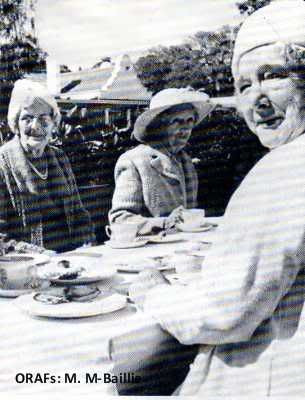
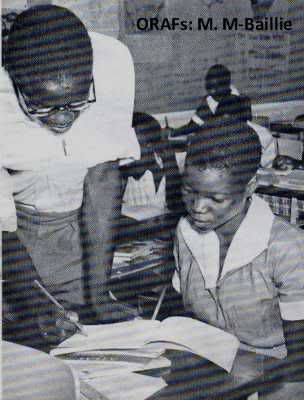
Since 1965, Old Age Pensions have been reviewed three times, in 1967, 1971 and 1972. The rate of Old Age Pension has risen from $39 per month maximum in 1965 to $57 per month maximum at present. In addition, the anomaly where by Asian and Coloured persons were paid at the rate of two-thirds of the European was removed.
In 1972 the assessment formula was changed to enable Old Age Pensioners to enjoy certain non- assessable incomes.
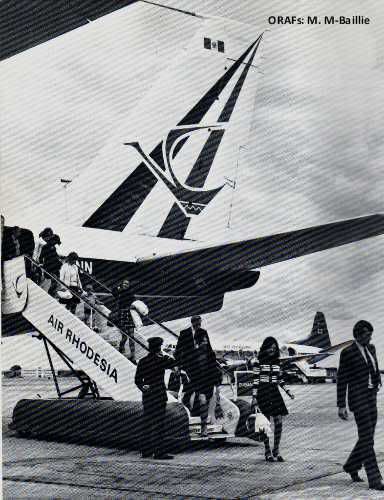 IMMIGRATION AND TOURISM
IMMIGRATION AND TOURISMThe Constitutional uncertainty arising from the 1961 Constitution and the impending dissolution of the Federation caused a net migration of nearly 26 000 Europeans in the years 1961 to 1964 inclusive.
In the last six years Rhodesia attracted 80 000 new Rhodesians from many countries to settle here and of these 80% were from Britain and ex Commonwealth countries. These new arrivals declared capital and assets worth $70 000 000 and for the most part have settled well in their new home.
They helped boost the European work-force in commerce, industry and agriculture, playing a vital role in raising the growing number of working Europeans, Asians and Coloureds from 89 000 in 1965 to more than 114 300 some ten years later. In no small measure they also helped to increase the Gross Domestic Product and since every new employed Rhodesian arriving in the country assists materially in providing employment for others, they contributed to general prosperity. Over the same period, Africans in employment increased from 656 000 to 848 000.
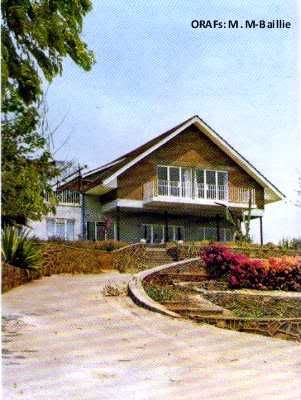
The Government has provided rented accommodation for 2 200 immigrant families and 1 533 homes have been built under 90% Government-guaranteed loans.

Visitors to Rhodesia have spent more than $25 000 000 a year in the country—an invaluable contribution to the foreign exchange position and an indication of the popularity of our attractions.
In seven years, tourist traffic has jumped from 285 000 to a record 405 000—an increase of more than 40 per cent.
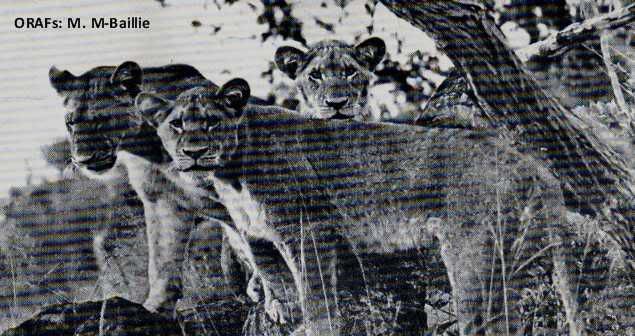
These visitors, deeply impressed by Rhodesia's prosperity and the country's natural attractions, become spontaneous ambassadors for us when they return to their own countries.
To keep pace with the increase in visitors, and also the growing numbers of Rhodesians who chose to spend their holiday in their own country, transport and accommodation facilities have continued to improve and expand.
Government and industry collaborated to introduce a hotel grading system and bring into existence a development fund. Many hoteliers invested substantial sums in improving their accommodation and service, while striving to keep tariffs in strict control. Today Rhodesian hotels offer some of the best value for money in the world.
Since 1965, the number of beds available in Rhodesia for travellers has increased from 7 500 to 10 400 and more will be available with the completion of new hotels at three major tourist spots in the near future.
Major development project have been imitated by Government for some of our leading tourist resorts, particularly at Victoria Falls , Wankie National Park and Kariba. The implementation of these schemes in partnership with private enterprises is now well advanced and holiday makers and tourist are already enjoying the benefits of the new facilities and amenities.
In tourism in general the need to work hand-in-hand with the commercial side of travel has long been recognised by the Government. One of the means of fostering good relations in this field has been the meeting place provided by the Annual Tourism Conference. This conference has gone from strength to strength, the one held in Bulawayo in 1972 being particularly notable for having thrashed out an enlightened policy of the very important subject of balancing the needs of
tourism with those of the environment.
In line with world trained and accentuated by the international fuel situation, the tourist industry must experience a temporary recession.
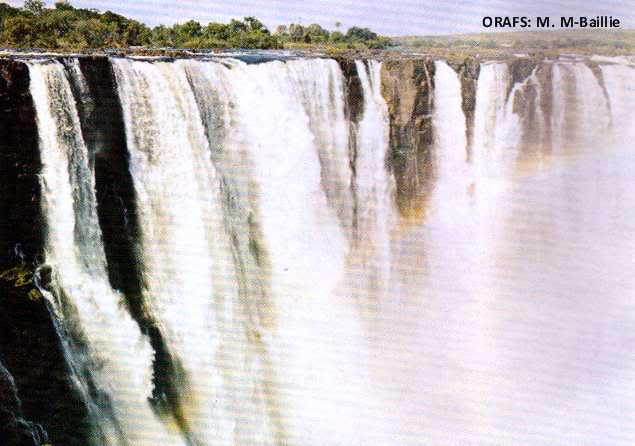 DEVELOPMENT OF THE COMMUNITIES
DEVELOPMENT OF THE COMMUNITIESRhodesians have always been proud of the standard of accommodation in the country and building has continued to expand in the last decade at a steady rate. In this period, building output has increased four-fold.
The upward trend is underlined by the figures for approved building plans. The value of plans passed for 1973 was $110 000 000 compared with $7 678 000 for 1963.
The development of local government has been prompted by transferring to rural councils the power to maintain, sublease and administer urban state land.
The Government, in seeking to rationalize local government within Rhodesia, implemented the Rural Councils Act, resulting in multipurpose local authorities being set up. The welfare of African communities has also been improved with clinic services and educational and recreational facilities.
In the past five years, African housing in urban areas has increased and the African Building Fund, helped by local authorities, has provided money for 22 390 units of housing.
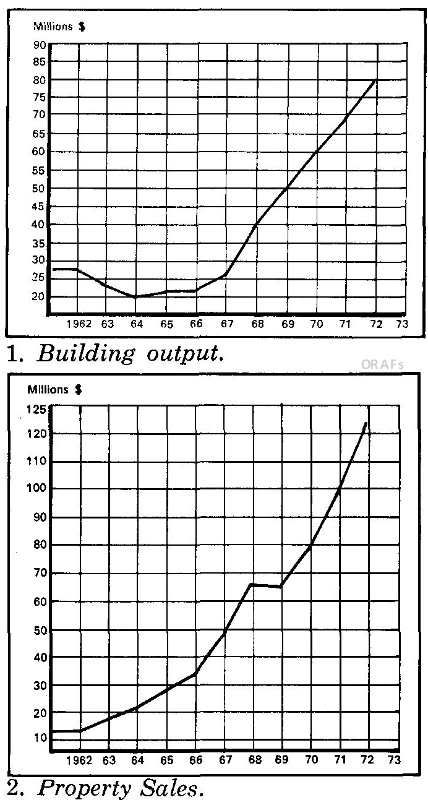
Today in Rhodesia's Tribal Trust Lands there are 3 400 000 people owning 3 000 000 cattle, 2 000 000 goats and 500 000 sheep and cultivating 1 300 000 ha of land. Their production could be quadrupled to produce an additional income of $50 000 000 a year for the inhabitants and the Government constantly explores ways and means of achieving this. Current development plans include the operation of irrigation schemes, primary co-operative societies and African Councils, all blended to the tribal social structure, and the establishment of additional administrative stations to ensure closer contact between Government and tribesman.
The Government's policy is to encourage the African people to conduct their own affairs at a local level through the medium of bodies such as Tribal Land Authorities and African Councils.
In addition, it is Government's policy to give wider responsibility to the African people at Provincial level by the establishment of Provincial Authorities and the progressive granting of powers to these authorities as they gain experience.
Tribal Land Authorities, African Councils and Provincial Authorities are under the control of the Chiefs and Tribal Leaders whom the Government recognizes as the leaders of the African people. Regular consultations take place between Government and the Council of Chiefs on matters concerning the African people.
The Government provides technical and financial assistance for the provision of development works and social services to the African areas. Development assistance is also given for the improvement of agriculture, the expansion of irrigation, the improvement of road communications, the development of trading facilities including assistance to co-operatives, the establishment of industries and the construction of townships which include home-ownership schemes.

Social services are supported by the Government with aid to schools and clinics and there is an extensive adult education programme.
In providing assistance, it is the Government's policy to help communities help themselves and assistance is given for community development projects which are supported by the people, and to which the people themselves contribute.
The success of this policy is highlighted by the fact that the budgets of African Councils have increased from $281 531 in 1962 to $9 046 461 in 1973/74. Similarly, the amount of money flowing through the African co-operative movement has risen from $506 280 in 1962 to
$4 386 142 ten years later.
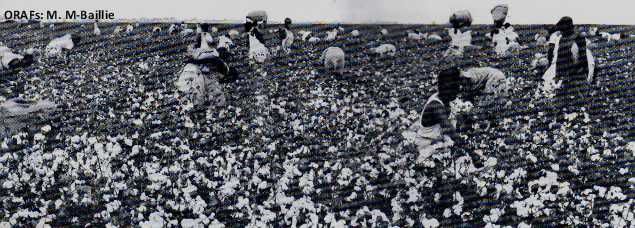
As a practical method of ensuring the preservation of the customs and traditions of the two main races living in Rhodesia,
the Government introduced a policy of provincialism. To this end, two Regional Authorities, one for the Matabele and one for the Mashona, are in the process of establishment in order to provide, in accordance with the entrenched provisions of the Land Tenure Act, the vehicle through which the further development of the people, by the people, for the people, can be attained.
The Land Tenure Act, a modern adaptation of the old Land Apportionment Act, gives to the African nearly 50% of Rhodesia and to the European nearly 50%, the remainder consisting of parks and wildlife areas. About 85% of the African area is Tribal Trust Land where the people live according to ancient lore and custom, modified by contact with Western civilization. Their interests there are absolutely paramount and protected, to any degree which the inhabitants themselves wish to retain, from European competition or intrusion.
In a determined effort to develop the potential of rural Africans, the Government established the Tribal Land Development Corporation in 1969. Tilcor has investigated a wide range of possible projects and has formulated a "growth policy" which provides for concentrated development of limited areas of known resources as pilot schemes. It is hoped that these will create an "aura of profitability" which will attract private enterprise to develop agriculture, industry and commerce in the Tribal Trust Lands.
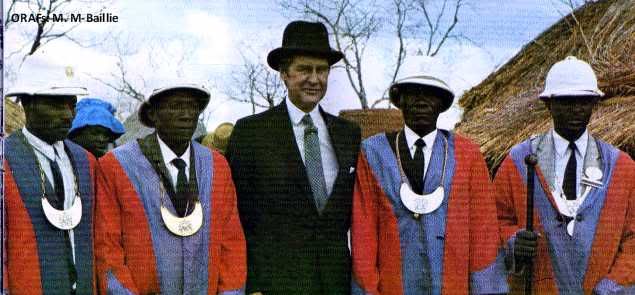
In 1970, Tilcor took over the giant Chisumbanje project from the Sabi-Limpopo Authority and it now comprises 1 416 ha under irrigation and includes a settler scheme, tenant training centre and an African residential area. This scheme has an ultimate potential of 40 470 ha under irrigation.
The viability of African irrigation has been clearly established at Chisumbanje and detailed planning for the next stage of expansion is under way.
The Katiyo Tea Estates have come into production and a wide range of other crops are planned.
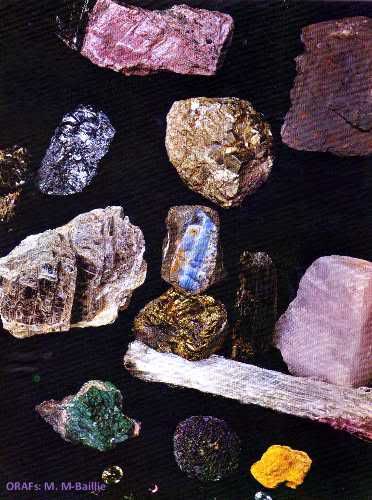 ECONOMIC RESOURCES
ECONOMIC RESOURCESThe Government was quick to recognize the important role that mining can play in the country's development and established a separate ministry. There followed a new era of confidence and enthusiasm in the mining field. The value of production in the industry more than doubled in the ten year period to the end of 1973.
The Government developed and maintained the mining and financial environment which made this achievement possible. The policy of promotional and developmental assistance was broadened and strengthened and professional and technical services increased. A mining cadet scheme was begun and a School of Mines is in the course of construction. An Institute of Mining Research has been established and the Mining Promotion Corporation set up to bridge the gap between the small and larger mining organisations.
Legislation has paved the way for optimum economic exploitation of all the country's natural resources and in recent years this has applied particularly to gold mining operations.
Agriculture is the most important foreign exchange earner in Rhodesia's economy and has continued to grow steadily, despite being the prime target of the economic war.
The Gross Domestic Product for the European agricultural sector grew from $87 000 000 in 1965 to $141 000 000 in eight years, an average growth rate of nearly 8% each year and an increase of over 60%. In 1970, Government introduced a three year minimum price guarantee for maize and cotton, designed to create a measure of long term confidence in the industries. Under another agreement, the producer prices for beef have been guaranteed. All these three commodities are important contributors to foreign exchange earnings. The remarkable increase in world commodity prices in 1973 has both boosted export earnings and made a noticeable impact upon farm incomes. Although Government cannot lay claim to any responsibility for the commodity price surge, it can nevertheless lay claim to creating a favourable environment for enabling these three commodities to take advantage of current favourable conditions. Agriculture is also susceptible to natural hazards and has suffered four serious droughts since UDI. To alleviate the immediate effects of these, the Government provided continuing financial assistance on a large scale to offset crop losses and safeguard livestock.
More than $8 000 000 has been paid out in drought relief between 1966 and 1972 and a further $20 000 000 has been set aside to combat the effects of the 1972/73 drought. Despite the many setbacks, agriculture has continued to grow. Since UDI the area under cultivation has increased one third and the European cattle herd has increased by almost two-thirds. The Government has aimed at self sufficiency in as many areas as possible and the wheat industry has been developed to the point where the country is not far short of its wheat requirements. Maize crops have continued to increase.
Apart from drought relief, the Government has provided a large amount of money to cushion the tobacco industry against the effects of the boycott. Money was provided for vital marketing and processing organisations to handle the many new commodities produced as a result of continued diversification.Since UDI, $8 000 000 has been provided by the Government to support crop prices. In 1971, the Government formed the Agricultural Finance Corporation to rationalize the many sources of Government credit to agriculture. This now includes the Farm Irrigation Fund, the Agricultural Diversification Fund, the Agricultural Assistance Board, the Tenant Farming Scheme and other schemes. Up to 1973, 3 500 farmers have been helped through the various schemes now operating under the A.F.C. and loan assistance to date stands at $53 000 000. The Government provided capital for storage, handling and processing of new commodities and facilities include three new maize silos, four new cotton ginneries and two new beef abattoirs. A new abattoir at Sinoia and a cold store at Gwelo are under construction.

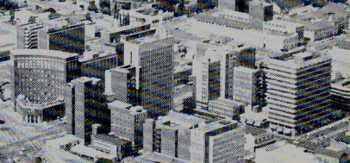
The Government adopted a new financial policy in agricultural marketing to give producers the maximum possible prices for commodities by reducing many of the costs once carried by the respective marketing boards.The Government created the Agricultural Marketing Authority in 1964 to serve as a corporate body for the Cold Storage Commission, the Grain Marketing Board, the Cotton Marketing Board and the Dairy Marketing Board. In 1971, the Agricultural Research Council was established to review and promote all aspects of agricultural research.

Also in 1971, the Government went a step further with the creation of the Agricultural Development Authority to co-ordinate and implement agricultural development. By 1975, this Authority will have achieved a blue print for the whole of Rhodesia.
The contribution made by the agricultural sector to both the balance of payments and to countering terrorism is significant and appreciated by all Rhodesians.
Commerce and industry has made a major contribution to Rhodesia's growth since the Government came to power and, particularly since UDI, the country has achieved great advances.
The national Gross Domestic Pro- duct has more than doubled since the present administration started:
Year: GDP1962: $600 000 000
1963: $618 000 000
1965: $695 000 000
1967: $741 000 000
1969: $918 000 000
1971: $1 125 000 000
1972: $1 261 000 000
1973: (forecast) $1374 000 000
The Gross Domestic Product of the manufacturing sector in 1962 was $105 000 000 and in ten years this had risen to $298 000 000. The index volume of manufacturing production has grown steadily in every category of manufacture, saving the country roughly $1000 000 000 in imports since 1965.
Category 1962Foodstuffs: 94.3
Drink and Tobacco: 84.4
Textiles: 93.7
Wood and Furniture: 74.2.
Non-metallic minerals: 98.3
Category 1965Foodstuffs: 110.1
Drink and Tobacco: 95.2
Textiles: 114.1
Wood and Furniture: 111.8
Non-metallic minerals: 103.2
Category 1972Foodstuffs: 184.3
Drink and Tobacco: 123.6
Textiles: 154.8.
Wood and Furniture: 179.9
Non-metallic minerals: 148.4
Category 1973Foodstuffs: 210
Drink and Tobacco: 140
Textiles: 265
Wood and Furniture: 195
Non-metallic minerals: 270
I
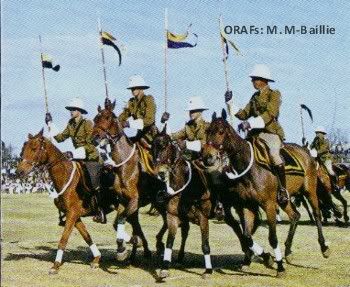
 SECURITY
SECURITYMore than ever before, the eyes of the country are turned towards Rhodesia's armed services; and more than ever before the Government is adamant that conditions in the services be sufficient to attract and retain the high calibre of serviceman that has been so invaluable to the country in the past.
Improvements have consisted of the introduction of re-engagement gratuities and extended service gratuities.
Review committees regularly examine general conditions of service and pay and allowances for all ranks. In the latest review particular attention has been given to the middle and lower ranks, and overall has resulted in meaningful increases of pay and allowances. A wide range of accommodation has been completed recently, again with the emphasis on facilities to induce married men in the lower ranks to serve longer periods.
The Government has been able to equip and maintain the defence forces at an acceptable level despite the difficulties of sanctions and, on the operational side, several new units have been formed. Specialised equipment has been obtained, greatly increasing the effectiveness of the deterrent.
The Government's objective remains the complete elimination of any terrorist presence within Rhodesia and great success has been achieved in this direction, thanks to the dedicated efforts of all ranks and all arms of the security forces.
Moreover -Rhodesian history will record the important contributions by the farming and other rural communities in this field.

The record of the Rhodesian Front Government in the field of Law and Order is clearly demonstrated by the fact that crime in Rhodesia has not followed world trends.
For a ten year period, reported cases of crime, as a percentage of the total population, dropped from 4,7% to 3,9%, which is a clear indication of why the B.S.A. Police is rated second to none.
The Rhodesian Front Government upholds the principle of constitutional Government. As in the past, it will not hesitate to deal severely with individuals or organisations who are trying to overthrow constitutional Government by means of subversion and terrorism.
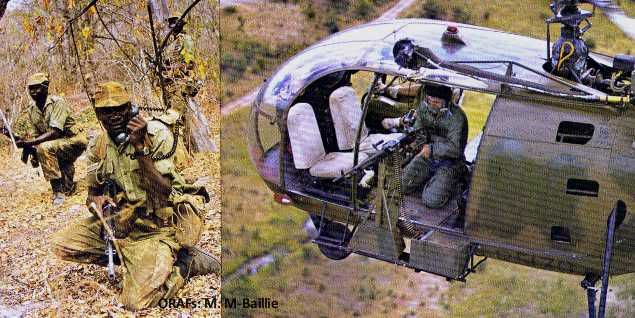
Two outstanding achievements can be credited to the present Government in the past decade; the maintenance of completely independent courts and the introduction of Southern Africa's first self-contained prison service.
Until 1969, Rhodesia, like its neighbours, used police to help run its prisons. Although contrary to international ideals, this was necessary because of great distances, poor communications and a sparse population. But in 1969 Rhodesia removed this dependence and established a system where prisoners are now held in custody, during trial and on con- viction, by a completely independent organisation.
Rhodesia's courts compare with any in the world. The independence of the High Court is unquestioned. The quality of the Magistrates' Courts is outstanding. In 1965 the Government introduced Regional Courts staffed by magistrates drawn from the Magistrates' Courts and these
intermediate courts, with increased jurisdiction, have greatly relieved the pressure on the High Court and have functioned extremely well.
With the exception of certain tribal courts, all Rhodesia's courts are very clearly divorced from the administrative and legislative branches of Government.
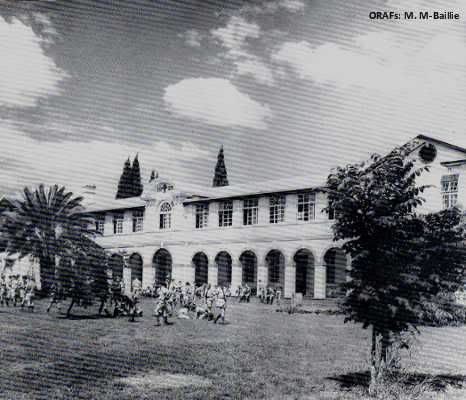 You and your future.Introduction.
You and your future.Introduction.So far ... so good. You have read the constitutional road to U.D.I, and have been refreshed by the record of success achieved in all fields of activity during the past eleven years of stable and imaginative Government by the Rhodesian Front.
There remains the vital question . . . "Where do we go from here"?
The Rhodesian Front offers you a bold and realistic programme to secure the future for this and later generations of Rhodesians.
Party Principles.The Principles of the Rhodesian Front are fundamental and unchanging. Every action, every law, every regulation will be examined against this background and must be consistent with the attainment of our objectives.
FORWARD POLICIESBroad DefinitionThe detailed policies of each individual portfolio of Government are shown in the booklet "Rhodesian Front Principles and Policies, 1973." Significant overall Government policies are highlighted in the ensuing paragraphs.
The policies of the Rhodesian Front are based on three fundamental principles:
* That central government remain in responsible hands; * That each community is entitled to maintain its own identity, traditions, customs and way of life; * That the land rights of different communities will be permanently protected.
To achieve this, the Rhodesian Front Government will uphold the principles of the Land Tenure Act which protects these land rights and ensures the paramount of interest of the two main communities in their respective areas.
All Government policies pertaining to social services, industry, farming, educational services, or labour relationships are governed by these three basic principles.
Because of the priority Government places on the overall development of the Rhodesian economy, Government will continue to build on its philosophy of community development.
Successes based on this policy have proved that the country gains a maximum return from development projects through the community efforts involved in these projects. In this way capital outlay is reduced to a minimum.
This policy ensures that communities realize the amount of time, money and effort that is required in the provision of essential services.
The policy of provincialization is a natural extension of the philosophy of community development, whereby the Africans will be given greater opportunity to accept responsibility in matters which affect their local affairs.
Based on Rhodesia's successes, as outlined in this brochure and on the proven political philosophies of the Rhodesian Front Government, the Rhodesian Front continues to have the will to govern and re-dedicates itself to stable government and sound forward planning of the development of Rhodesia. This will ensure the permanent establishment of all communities living in peace and harmony.
International Recognition and Sanctions.The Rhodesian Front will strive to achieve formal recognition of our sovereign status and the removal of sanctions by those countries with whom we have an affinity. To this end, we will continue to seek and use every opportunity to make contact with friendly and potentially friendly countries and to promote the justice of our cause, our right to recognition and our strategic place in the anti-Communist arena.
However, we will NOT sell our birthright, jeopardize our security or debase our sovereignty to buy recognition.
Southern AfricaGeographically and economically we are an intrinsic part of Southern Africa and our destiny is secured by the enormous strength that the region possesses.
The Rhodesian Front Government will play an active and leading role in the promotion and development of inter-dependence and regional co-operation whilst retaining always our national identity and our own political philosophy. This policy envisages the creation of an economic bloc, close co-ordination of defence and co-operation and joint planning in the realms of power and water resources, transportation and tourism.
The Constitution BOLD
The principles of the Constitution reflect clearly the Government's policy of maintaining standards and there will be no deviation from this. Thus power, through the reins of Government, will rest in the hands of those best fitted to use it and whose proven attributes will ensure that it is administered with firmness and justice. Unlike certain other systems, decisions will be made by those responsible for their execution and answerable to the electorate for their actions.
As Provincial Authorities evolve, the role of central Government will alter with the emphasis being placed on international, regional and national affairs with less influence on the day-to-day administration of Provinces. The two-chamber concept of the legislature will be retained.
Electoral Procedures.In the interests of harmony and for constitutional security, separate voting rolls and Electoral College representation will be maintained.
Land Tenure.The security of our home and our land is enshrined in the Land Tenure Act, which will remain inviolate in principle.
Provincialisation.Under the policy umbrella of a strong Central Government, the administration of many facets of life will devolve upon Local and Provincial Authorities on an evolutionary programme. The rate at which power will be delegated to local and provincial level will be determined by the ability to absorb and exercise responsibility.
This positive policy will ensure for each main race an effective control over its own domestic affairs. For the African it will provide, with the co-operation and direction of the Chiefs, a platform for responsible political ambition and a training ground in the art of administration.
The Branches of the Public Service necessary to support the provincial administrations will guarantee stimulating employment opportunities in the African area for the educated African.Overall, Provincialisation will assist materially in the promotion of harmonious relations between all Rhodesians.
Defence.Communist influence and military power is evident in parts of East and Central Africa as it is in most other parts of the free world. In full collaboration with our neighbours we shall meet and beat this challenge wherever and whenever it may come.
The Rhodesian Front will expand our regular Army and Air Force to a level which will enable them to maintain the security of our border and to search out and destroy terrorist infiltrators. Our aim is to eliminate progressively the necessity to call up Territorial and Reserve forces.
Law and Order.We will uphold vigorously the rule of law in Rhodesia. For this purpose we will maintain the B.S.A. Police at peakefficiency and prepare the Police Reserve for duties in aid of the civil power in times of emergency.
Economic Resources BOLD
The Rhodesian Front will provide the stable Government and the financial climate within which private enterprise will flourish and our vast economic resources will be exploited for the benefit of all in Rhodesia.
Stimulus will be given to the settlement of the land and the controlled expansion of our agricultural industry to meet a growing world demand for food and natural raw materials.
We will capitalise on the world energy requirements and exploit our immense coal deposits to feed domestic and export demand. The establishment of an oil from coal complex will be pursued vigorously.
High priority will be given to the promotion of development of our un-tapped reserves of minerals.
There will be many opportunities for private enterprise to establish secondary industries to process our mineral and agricultural products. This will create considerable new employment and improve the price at which the end product issold, thereby increasing our export earnings.
Incentives will be provided to spur the decentralisation of this development throughout Rhodesia.
Water.Today, as the development and conservation of our national resources becomes increasingly important, it is more than ever necessary to move to a more sophisticated approach. The Government, through the Ministry of Water Development, will develop the total water resources of the country in a manner most beneficial to Rhodesia.
In the past, the acquisition of rights to water by individuals was based primarily on the principle of first come, first served.
Now, the Ministry is preparing new legislation that will enable each catchment to be planned and a more equitable allocation of resources to be made.
In this way, we will ensure that the development of our water resources goes hand-in-hand with general development and the country's full potential will be realized in a progressive manner.
Immigration.To provide the skills, expertise and finance for this development, we will mount a sustained campaign to seek out and attract to this country immigrants of calibre from various centres in the world.
University of Rhodesia.In consultation and in co-operation with the University authorities, we will expand the range of degree courses on offer.
The courses and the student registration in each faculty will be geared to meet the needs of the economy.
Tribal Land Development.We have a positive plan to raise the standard of living in the Tribal Trust Lands. Through our proven community development philosophy, communities will be encouraged to help themselves. The Rhodesian Front Government willprovide motivation, financial assistance and technical expertise to aid development in all spheres.
Agricultural development will be based on expanded irrigation, the use of livestock as a marketable asset and controlled marketing.
New townships will be established in the African area which will provide commercial trading facilities, the incentive to earn and buy and employment opportunities for professional, technical and business personnel.
Secondary industry will be given real inducements to establish new plants in the Tribal Trust Lands or on the periphery of the African Area.
Population Control.The rate of population increase is outstripping the ability of the economy to absorb it.
A co-ordinated control programme involving all arms of Government, organised representative bodies in the private sectorand provincial and local authorities has been devised and will be implemented.
This will ensure that the joint requirement of means and motivation is fully met.
Racial Harmony.The Rhodesian Front Government recognises the vital importance of racial harmony in the context of Rhodesias security and development.
Attention will be based on the following fundamentals:—
(a) Respect for the dignity of the individual;
(b) Freedom of worship and association within the law;
(c)) Respect for the customs, traditions and the way of life of each racial group;
(d) The right to privacy of each racial entity, either individually or collectively, in the social, educational, sporting and residential fields.
I
 Conclusion.
Conclusion. To paraphrase the foreword by the Party President in the booklet on Principles and Policies:— "The Rhodesian Front is conscious of the great responsibilities which rest on their shoulders in setting out a blueprint for the future. The Front firmly believes that our Principles and Policies will ensure for the European a permanent, strong and immovable stake in Rhodesia. At the same time, they will safeguard the rights of the African. It is the Front's policy that there shall be equal
opportunity for all people."
THE RHODESIAN FRONT IS THE ONLY PARTY THAT CAN GUARANTEE THE WELL-BEING OF ALL RACES IN THIS LAND OF OURS, RHODESIA. BOLD
Published by D. Frost, The Rhodesian Front. P.O. Box 242, Salisbury.
Printed by Irwin Press (1973) (Pvt.) Limited,
Private Bag 6655, Kopje. Salisbury.
End of Article

Recompiled by Eddy Norris, for no or intended financial gain but rather to retain the wonderful memories of Rhodesia.
Booklet was made available by Marcus Main-Baillie. Thanks Marcus.
